Silsbee
On our last day we went birding with our friend Vaughan. An early start (as usual!) saw us heading along I10 towards Beaumont, around Beaumont and up to Silsbee. Taking the 92 north from Silsbee we found Gore Store Road (on the left) and drove along there getting a singing Chipping Sparrow on the way. Before Fire Tower Road, on the left, is a sandy track. We drove down there and stopped about 100 metres in. Barely had we left the car when we heard one of our target birds singing!
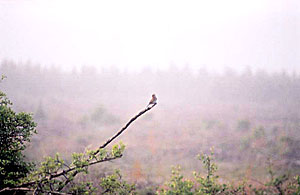
First view of Bachman's Sparrow
We walked about 20 metres down a side track and almost immediately found our main target singing from a low branch. It was a misty day with the sun just rising and beginning to clear the mist and was one of those very memorable experiences – just the one bird singing, and what a bird – our first ever Bachmans' Sparrow
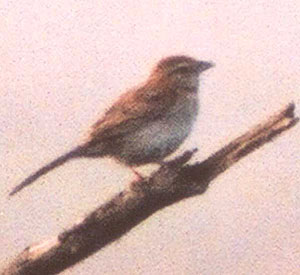
Bachman's Sparrow
Being a sparrow-lover this was second only to the Nelson's Sharp-tailed Sparrow for me. We got closer and closer until it easily filled a 'scope view and then almost filled a binocular view! The decent photgraphers amongst us (Vaughan and a chap we met there) must have got excellent shots despite the weather, which did improve as we watched the bird.
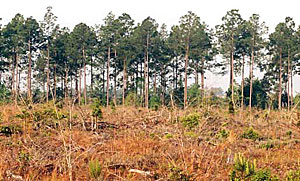
Bachman's Sparrow habitat
This habitat was an open, felled area within a pine wood. In the picture above the foreground open area is the habitat favoured by Bachman's Sparrow. The tall pines in the background are good habitat for Pine Warbler and Brown-headed Nuthatch. As we walked further into the cleared area we added White-eyed Vireo, Barn Swallow, Brown Thrasher, Hooded Warbler and Eastern Wood-pewee. Only a hundred or so metres from the Bachman's Sparrow we heard our second target bird singing. After a few minutes searching we found the bird, a dazzling male Prairie Warbler, and watched it as it flew from tree to tree singing from the topmost branches. As we moved off from the bird a Yellow-breasted Chat began to sing from the wood, putting in an occasional, brief, appearance and another male Bachman's Sparrow was found, this one rather distant but could still be heard singing.
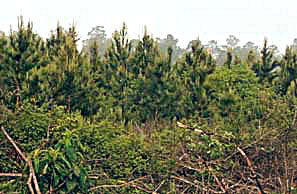
Prarire Warbler and
Yellow-breasted Chat habitat
Back near the car we again watched the first Bachman's, a bit higher and further away this time but easily seen in the 'scope. We also picked up a male Pine Warbler and two Brown-headed Nuthatches, plus, as we stood by the car, a singing Sedge Wren.
As we drove south through Silsbee Helen spotted an Eastern Bluebird on a telegraph wire, which waited until we had turned round to go back and see it, and Vaughan spotted an American Robin, which again waited as we again U-turned to see it. One more Eastern Bluebird was seen a bit further towards Silsbee.
Later on that day, after returning to Boy Scout Woods we drove north again to recently flooded ricefields near China on route 90, east of Beaumont. We had heard tell of many shorebirds here and had great hopes.
The ricefields were easily found and we found it possible to drive along the ends of them on a mud track and then up and down between them on the tracks that seperated each field.
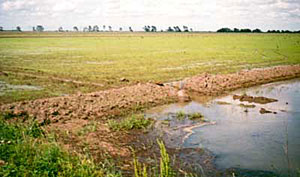
Ricefield near China, Texas
So, what did we see? I started counting birds but there were too many to keep tally of as we moved field to field – Short- and Long-billed Dowitchers, Hudsonian Whimbrel, Willet, Buff-breasted Sandpiper, American Golden-plover, Semipalmated Plover, Greater and Lesser Yellowlegs, Pectoral Sandpiper and Black-necked Stilt – many of each. Also here we had two female Northern Harriers and hundreds of Red-winged Blackbirds and grackles. However, we had a target species here, a bird much wanted. And we found it. We searched the orangy-coloured dowitchers for something much redder, then there it was, a summer-plumaged Hudsonian Godwit. The colour was just as seen in Sibley – very obvious once found. Unfortunately, very soon after locating this bird a few birds decided to fly off into the sun and despite later searching we had to conclude that any Hudwits were amongst them.

